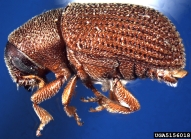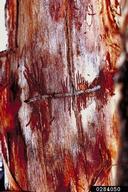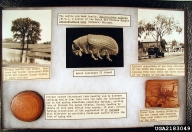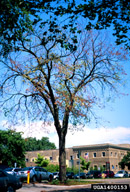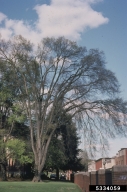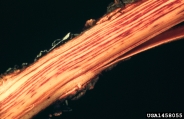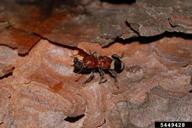Native elm bark beetle
Hylurgopinus rufipes (Eichhoff) (Coleoptera: Curculionidae, Scolytinae)
Orientation to pest
Native elm bark beetle, Hylurgopinus rufipes (Eichhoff), is a native North American insect associated with various species of elm and other trees. Before the introduction of the exotic pathogen causing Dutch elm disease, this insect was of minor importance. During the historical period of mass epidemics of Dutch elm disease, this native bark beetle served as a vector of the pathogen. This process continues in wild lands where native elms survive and reproduce before succumbing to Dutch elm disease. Although H. rufipes has been displaced over much of its range by the introduced smaller European elm bark beetle (Scoytus multistriatus [Marsham]), Hylurgopinus rufipes remains the dominant vector of Dutch elm disease in northern areas where S. multistriatus is limited by low temperatures. Adult beetles emerge in early spring and fly to healthy elms to feed for a short period in the bark of branches and twigs. After feeding, beetles fly to dying and recently dead trees for oviposition. Females construct egg galleries that are oriented horizontally, across the grain of the wood. Eggs are laid along the egg gallery and larvae feed in tunnels that run parallel to the grain and perpendicular to the egg gallery. Larvae pupate in small cells at the ends of the feeding gallery. In some instances, larvae and newly developed adults will overwinter in these galleries, with adults emerging the following spring through small round exit holes. At other times, adults emerge before winter; these adults fly to healthy elm trees to feed on branches and to chew overwintering galleries in the bark, generally of the lower stem. If as larvae these adults had developed in trees dying from Dutch elm disease, they are very likely to carry spores of the fungus that causes Dutch elm disease. When they visit healthy elm trees to feed on branches or to create overwintering galleries, these beetles can transmit the pathogen. There are one to two generations of this bark beetle per year, depending on location.
Hosts commonly attacked
Rock (Ulmus thomasii Sarg.) and American elm (Ulmus americana L.) are the major hosts of this bark beetle, but it also attacks American basswood (Tilia americana L.), and species of ash (Fraxinus).
Distribution
This native bark beetle was formerly common throughout eastern North America from northern Alabama and Mississippi to southern Canada, but it has been displaced over most of this area by the introduced smaller European elm bark beetle. It is, however, still common in colder areas such as northern New York, New England, northern Minnesota, and southern Canada, where the smaller European elm bark beetle does not survive winter temperatures.
Images of native elm bark beetle
| Figure 1. Adult native elm bark beetle, Hylurgopinus rufipes | Figure 2. Egg gallery (horizontal) and larval galleries (vertical) of the native elm bark beetle | Figure 3. Historical record of the change the new pathogen made in the importance of this bark beetle |
| Figure 4. Two views of American elms dying of Dutch elm disease | Figure 5. Streaking and discoloration of the vascular tissue in elms infected with Dutch elm disease | Figure 6. The clerid Enoclerus nigripes an important predator of the native elm bark beetle | |
Important biological control agents related to this pest species
The major predator of this bark beetle in Connecticut is the clerid Enoclerus nirgripes Say and the principal parasitoid is Spathius canadensis Ashmead.
Web links for information on native elm bark beetle
- Dutch Elm Disease "How to" Publication | USDA Forest Service, Northeastern Area
- Extension Fact Sheet | University of Minnesota
Provides information on management procedures: sanitation, chemical control, sampling, and pruning - Fact Sheet | Natural Resources Canada
Articles
- Thompson, H. E. and J. G. Matthysse. 1972. Role of the native elm bark beetle, Hylurgopinus rufipes (Eichh.), in transmission of the Dutch elm disease pathogen, Ceratocystis ulmi (Buisman) C. Moreau. Search Agriculture, (Entomology) 2(1, V), 16 pp.
- Gardiner, L. M. 1981. Seasonal activity of the native elm bark beetle, Hylurgopinus rufipes, in central Ontario (Coleoptera: Scolytidae). The Canadian Entomologist 113: 341-348.
